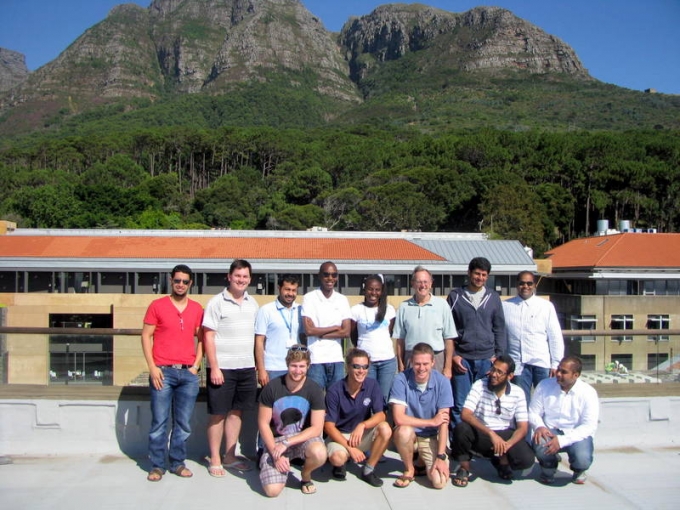Introduction to Radar: Class Photograph 2014
Course Information
Dates: 3-7 February 2014
Course code: EEE5119Z
Venue: Menzies Seminar Room, 6th Floor, Menzies Building (Upper Campus), University of Cape Town
Course Description
Course Overview
The course covers the areas listed below:
- Overview of key principles: Radar components and processing, radar system functions, radar types, radar applications
- Radar range equation: Point target derivation, system noise, SNR, system losses
- Radar waveforms and ambiguity function: CW, single pulse, pulse soppler, coherent vs incoherent, range estimation and range ambiguities, ghosts, sensing Doppler frequencies – Doppler ambiguities, pulse compression, FMCW, phase coding, other waveforms, eg. passive radar, noise radar, ambiguity function definition and properties
- Transmitters: Waveform generation, power conversion, mixers, duplexors, RF devices – magnetrons, and travelling wavetubes, synchronisation and timing issues
- Antennas and phased arrays: Radiation patterns, beamwidth, sidelobes and gain, antennas, phased arrays
- Propagation, scattering and clutter: Propagation, attenuation, refraction, diffraction, etc., scattering, radar cross-section, target fluctuation, clutter, surface and volume clutter, ground clutter for airborne radar
- Radar receivers RF aspects: Preamplifiers, down-conversion, limiters, noise figures
- Radar signal processing: Matched filters, range processing, Doppler processing, Fourier transforms, conventional phase shift beamforming, STAP
- Detection and the radar equation: Detection principles, statistical detection theory, pulse envelope detector, radar equation, integration, CFAR
- FMCW radars: Doppler effect, FMCW/Pulse compression, FMCW, Ambiguities
- Parameter estimation and tracking radars: Key basics of estimation theory, range accuracy, frequency estimation, direction of arrival, tracking radars – lobing and monopulse
- Synthetic aperture radar: Cross-range resolution, synthetic aperture and resolution, azimuthal chirps, SAR image formation, MoComp.
Presenter
Prof Douglas A. Gray is the Professor of Electrical Engineering at the Adelaide University and Director of the University of Adelaide Radar Research Centre.
He received his Ph. D. from the University of Adelaide, in 1973 and then spent 20 years with the Defence Science and Technology Organisation, applying signal processing to sonar and electronic warfare and leading various research and development programs.
From 1993 to 2006, he was Deputy Director of the Cooperative Research Centre for Sensor Signal and Information Processing and led a number of programs and projects in radar, sonar and GPS.
His current radar research interests are in MIMO radar, radar for monitoring weather and bushfires and synthetic aperture radar for surveillance and environmental monitoring.



